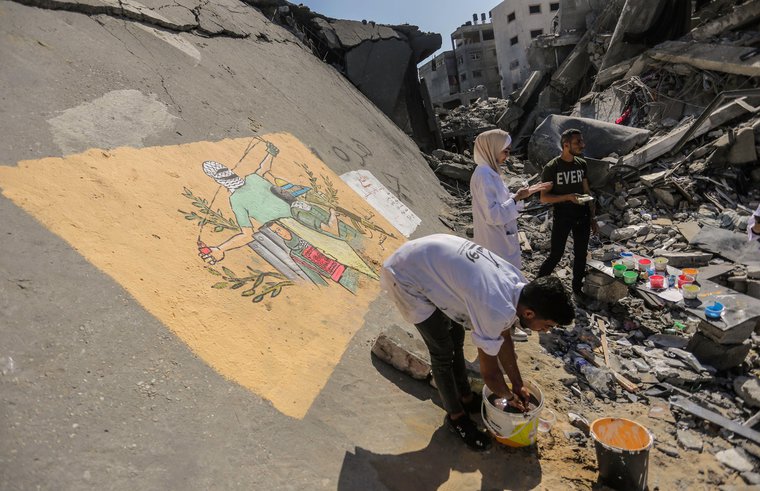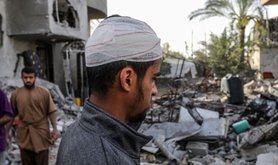
Cracks in the Middle East’s stability grow wider as US influence wanes
With the region experiencing social unrest, greater influence of Russia and China, and Israel’s increasing independence, the future is uncertain


The reopening of the US Consulate in East Jerusalem, which reverses one of Trump’s key moves against the Palestinian Authority, was the most significant outcome of the US secretary of state Antony Blinken’s four-state visit to the Middle East this week.
President Joe Biden’s top diplomat also announced immediate support for reconstruction in Gaza, while maintaining strong support for Israel. Yet Blinken has not proposed new peace talks, nor has he engaged with Hamas, which the US and Israel still deem to be a terrorist organisation. Instead, his quick tour through Jerusalem, Ramallah, Cairo and Amman was mainly focused on consolidating the ceasefire. If it helps, good, but it still does nothing to address the underlying issues.
This is part of a wider US reorientation from the Middle East to the Indo-Pacific, which may prove to be a long-term shift. It is one of five significant political processes underway, all of them interconnected. The other four involve: Russia and China increasing their influence in the region; Israel becoming less reliant on the US; the success of regional autocracies; and least noticed but most significant, social stirrings across the region that may turn all the other trends on their heads.
Washington’s involvement with Israel will of course continue, more military aid will pour in, US troops will maintain their now-permanent presence in the Negev desert, and arms corporations will continue to reap the rewards. More widely, US military bases will be maintained in Bahrain and Qatar, and there will be forces present in Kuwait, Saudi Arabia, the Emirates and Oman. Even in Iraq and Syria, minimal forces will be kept on, yet the overall significance of the region, including West Asia, will decrease as the withdrawals from Iraq and Afghanistan continue.
End of the oil rush
There is a clear sense that the American public is over the decades-long wars in the region, while veterans have said publicly that the wars in Iraq and Afghanistan were not worth fighting, and Biden gets that.
It’s also worth noting that when Jimmy Carter focused US policy on the Middle East in the late 1970s, the region’s oil and gas supplies were far more significant for the United States than now. The region simply isn’t as important any more to Washington.
And this diminishment of US dominance is allowing other states in. Russia is already the main winner, with its naval base in the Syrian port city of Tartus and the nearby Khmeimim airbase. Its ubiquitous ‘private’ security outfit, the Wagner Group, has been operating in Libya, while a naval logistics base is being set up at Port Sudan that will provide invaluable support for Russian naval vessels operating east of Suez. It continues to export arms to Iran and Syria, as well as US allies, Egypt and Turkey. Even Saudi Arabia is interested in Russia’s S-400 anti-aircraft/anti-missile system and Su-35 fighter aircrafts.
Although Russia lacks economic prowess, China doesn’t and imports nearly 50% of its oil from the region. In the past decade, it has expanded its naval reach, with frequent deployments to the Gulf and the Red Sea, and in 2017 it opened a naval base in Djibouti on the Horn of Africa.
China has become a major presence at regional arms fairs, of which there are plenty, and while one of its major successes has been the sale of drones in the region, its state-owned shipbuilding group, CSCI, also opened an office in Dubai in 2016, according to the 26 May print edition of Jane’s Defence Weekly.
Israel has increased its economic growth and trading with Arab states, and is far less dependant on US aid than previously
Turkey continues with its deployments in Syria and Libya, while remaining critical of Israel. Meanwhile, India’s ruling Bharatiya Janata Party has taken the opposite view in the recent conflict, with the Hindu Nationalist Hindutva worldview seen as dovetailing in many ways with Zionism.
It all adds up to a regression of US influence, which is compounded by Israel’s work over the last two decades to limit its dependence on the US. Even though there is still significant co-development and co-production with US arms corporations, Israel’s own arms industries have grown so much in size and sophistication that Washington’s influence has become far less significant.
Allied with this is Israel’s high rate of economic growth, its increased trading with Arab states in the region and the radically decreased importance of US aid, which was equivalent to nearly 10% of its economy in 1981 and has dropped to just over 1% by 2020. to One further sign of independence is the conclusion of the diplomatic accords with Bahrain and the United Arab Emirates, a move that damages Palestinian aspirations, while making Jewish Israelis feel more secure.
Closely added to this is the next factor, the continuing consolidation of autocratic power across the region. Almost all the autocratic leaderships of 2011 have not only survived but thrived, much to Israel’s pleasure, as it appears to be invariably easier to deal with autocracies than messy democracies.
The average Jewish Israeli has reason to feel more secure than ever, with the country more independent of American influence and the military more confident of maintaining the status quo, albeit with occasional bursts of intense bombing in Gaza.
Anger on the margins
If that sounds like a terrible forecast for Palestinians and a positive one for the Israeli prime minister, Benjamin Netanyahu, and his supporters, there is still the final factor to take into account – the regional potential for revolt that is now becoming more visible. A most recent example is the sudden outburst of protests in Oman this week, which is surprising as it is usually so rigidly controlled. Although this may appear to have come out of nowhere, it has been brewing for months due to economic problems exacerbated by low oil prices.
Moreover, there has also been persistent civil unrest in Iraq for the past 18 months, with more than 1,000 killed and tens of thousands injured, while Lebanon has experienced protracted civil unrest caused partly by corruption and mismanagement in high places, but also by endemic socio-economic marginalisation.
In Israel itself, anger and bitterness within the minority Arab population persists and is being exacerbated by the Israeli policy of mass arrest, with more than 500 Palestinians alone being detained since the ceasefire came into effect last week and further reports of police violence.
There is little appetite in Israel for a full and just settlement with the Palestinians, while across the Middle East as a whole, elite communities are largely satisfied as autocratic leaders give an illusion of control. However, the region faces environmental pressures as it is already experiencing the early consequences of climate change, and depends inordinately on its bountiful fossil carbon resources, especially gas and oil.
As demand falls for both of these polluting fuel sources, so do prices. And rising unemployment leads to more resentment, bitterness and anger on the margins. On top of all this is the impact of the COVID-19 pandemic as it exacerbates current inequalities and makes life even harder for millions.
What appears to be stable, although unjust, is more fragile when you take a closer look. As the Leonard Cohen song, ‘Anthem’, puts it: “There is a crack in everything. That’s how the light gets in.”
Read more
Get our weekly email




Comments
We encourage anyone to comment, please consult the oD commenting guidelines if you have any questions.